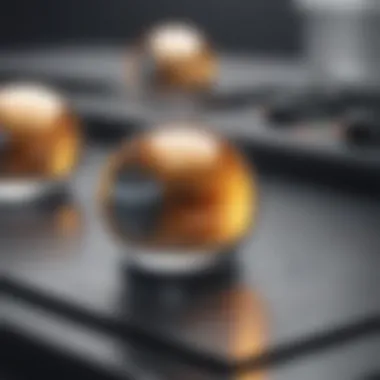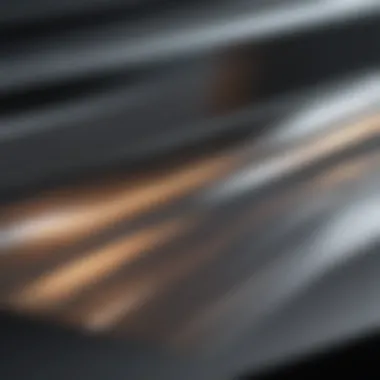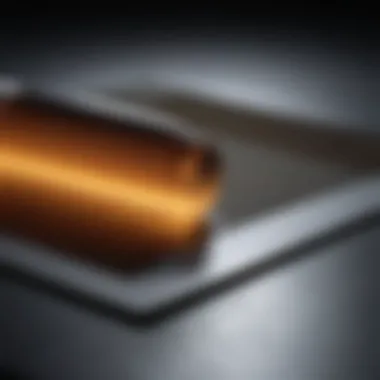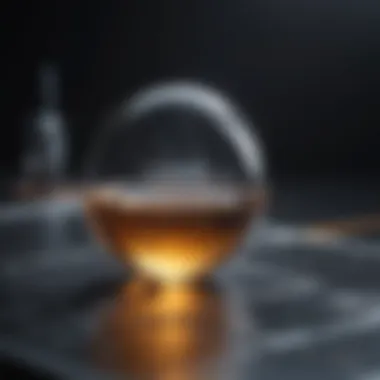Exploring Piezo Film Sheets: Principles and Innovations


Intro
The evolution of materials science has introduced several transformative technologies, one of which is piezo film sheets. These sheets can convert mechanical stress to electrical energy and vice versa. This dual functionality positions them as critical components in various applications ranging from consumer electronics to advanced engineering solutions. Understanding the fundamental principles behind piezoelectricity and how these materials work is essential for leveraging their potential.
In this article, we will provide a detailed overview of piezo film technology, exploring key aspects such as their applications, innovations, and the challenges faced in their development. We aim to serve not only students and researchers but also professionals looking for insights into this fascinating field.
Methodology
Study Design
The exploration of piezo film sheets is rooted in interdisciplinary research that draws from material science, electrical engineering, and applied physics. A comprehensive review of existing literature forms the backbone of this study. Academic journals, industry reports, and technical specifications are analyzed to extract relevant data.
Data Collection Techniques
Data for this investigation comes from multiple sources:
- Academic Journals: Peer-reviewed articles detailing experimental findings and theoretical advancements.
- Industry Reports: Insights from market research and technological trends reflecting current applications.
- Technical Specifications: Documented performance metrics from manufacturers of piezo film products.
By employing a synthesis of these sources, we can furnish a robust understanding of piezo film's characteristics and applications.
Discussion
Interpretation of Results
Recent advancements in piezo film technology indicate a significant increase in efficiency and versatility. The integration of these films into consumer products is becoming more common, exemplifying their practical applications. Devices designed for energy harvesting utilize piezo films to convert vibrations into usable electrical power, demonstrating their importance in the quest for sustainable energy solutions.
Limitations of the Study
While the study offers valuable insights, it is crucial to recognize its limitations. Most of the literature focused on laboratory-based research may not fully encapsulate real-world conditions. Additionally, emerging technologies may not yet be thoroughly vetted or documented, which can lead to gaps in the available data.
Future Research Directions
The future of piezo film technology appears promising. Several areas warrant further exploration:
- Material Enhancement: Research into new polymer compositions to improve piezoelectric properties.
- Integration with Smart Technologies: Investigating how these films can be embedded in IoT devices for enhanced functionality.
- Sustainability: Developing eco-friendly production processes to reduce environmental impact.
In summary, piezo film sheets represent a critical frontier in both material science and energy solutions. Ongoing research and technological integration are necessary to unlock their full potential in various industries.
Preface to Piezo Film Sheets
Piezo film sheets represent a notable innovation within materials science, delivering profound implications for various sectors. These films exhibit the capability to convert mechanical energy into electrical energy, and vice versa, providing a key function in systems where energy conversion is fundamental. The significance of piezo film sheets lies not only in their operational principle, but also in their versatility across applications ranging from medical devices to consumer electronics and automotive technologies.
Understanding piezo film sheets is crucial because they embody a practical solution to energy harvesting and sensing technologies. Their lightweight and flexible nature enhances integration into a variety of products without adding substantial bulk. Moreover, advancements in material science have expanded their functionalities, leading to refined tools and systems that enhance performance and efficiency in applications.
Exploring the characteristics of piezo film is vital for students and professionals seeking to grasp how these elements are shaped by their compositions and historical contexts. The study of piezo film sheets encompasses not only what they are made of but also how they were developed over time. Adopting a comprehensive view of their evolution reveals the challenges and triumphs that paved the way for the present-day use of piezoelectric materials.
In summary, piezo film sheets play a central role in modern technology by providing innovative solutions to pressing energy and sensing challenges. By delving into their composition and historical development, we gain insights into their value and potential applications in diverse fields.
Fundamental Principles of Piezoelectricity
The study of piezoelectricity is crucial in understanding how piezo film sheets operate. Piezoelectricity refers to the ability of certain materials to generate an electrical charge in response to applied mechanical stress. This phenomenon opens up diverse applications, including energy harvesting and sensors. The principles governing piezoelectric materials establish a foundation upon which the innovative applications of piezo film sheets are based.
Mechanisms of Piezoelectric Effect
The piezoelectric effect arises from the internal structure of piezoelectric materials. When mechanical stress is applied, it disrupts the material's symmetry. This disruption generates a displacement of charge centers within the material, leading to an accumulation of electrical charge on surfaces. The effect can be divided into two main types:
- Direct Piezoelectric Effect: This occurs when an external force is applied and results in the generation of voltage.
- Converse Piezoelectric Effect: In this instance, an applied voltage causes a mechanical deformation in the material.


These mechanisms are harnessed in various applications, such as ultrasonics and actuators. Understanding these mechanisms is essential for both researchers and practitioners in the field, influencing their use of piezo film sheets in new technologies.
Mathematical Models and Calculations
The mathematical modeling of piezoelectric behavior is important for predicting performance and optimizing designs. Generally, the relationships governing piezoelectric materials can be described using constitutive equations. The following components are considered in these models:
- Stress (σ) and Strain (ε): These physical quantities are given as inputs, affecting the material's response.
- Electric Displacement (D): Related to the electric field and charge density, it characterizes the electrical response.
- Piezoelectric Coefficients (d): These coefficients define the relationship between mechanical and electrical states.
The fundamental piezoelectric equation can be expressed as follows:
[ D = d_ij \sigma_j ]
Using this framework, engineers and scientists can predict how piezo film sheets will behave under various conditions. Optimization of these materials hinges on precise calculations, helping to improve design choices and applications in technology.
Understanding the fundamental principles of piezoelectricity is essential for the advancement of piezo film technology and its real-world applications.
In summary, the fundamental principles of piezoelectricity underpin the functioning of piezo film sheets. Grasping the mechanisms of the piezoelectric effect, alongside the mathematical models governing their behavior, provides significant insights into their applications. This knowledge serves as a building block for future innovations and improvements in piezoelectric materials.
Fabrication and Characteristics of Piezo Film Sheets
The process of fabricating piezo film sheets involves careful control of materials and methods. Understanding the different aspects of production enhances the knowledge of their characteristics, which significantly affects performance. This topic is crucial as it determines the efficiency, durability, and potential applications of piezo film sheets. The interplay between material selection and the production process informs the overall effectiveness of these sheets in various technologies.
Materials Used in Piezo Film Production
The manufacturing of piezo film sheets relies on specific materials that exhibit piezoelectric properties. The most commonly used material is polyvinylidene fluoride, or PVDF. This polymer is valued for its excellent mechanical flexibility and strong electroactive response. Other materials may include copolymers of PVDF, such as trifluoroethylene, which further enhance performance under specific conditions. Additionally, ceramic materials like lead zirconate titanate (PZT) are sometimes used when higher precision and power capacity are required.
- PVDF: Known for its chemical stability and lightweight, making it suitable for various applications.
- Copolymers: Improve the response and sensitivity of the film sheets.
- Ceramics: Provide enhanced power capabilities, but are less flexible.
Production Methods and Processes
Several techniques are employed in the production of piezo film sheets. These methods directly impact the uniformity and quality of the final product. One common technique is solution casting, where a polymer solution is poured onto a flat surface to form a thin film. After casting, the film is heated and stretched to induce a piezoelectric effect. Another process is electrospinning, which creates nonwoven nanofiber mats that can exhibit piezoelectric properties when properly aligned.
- Solution Casting: Good for creating larger sheets, but may result in some defects.
- Electrospinning: Offers high surface area and tunability via fiber alignment.
- Dielectric Poling: A critical step where an electric field is applied to enhance the piezoelectric response during manufacturing.
Key Physical Properties
The physical properties of piezo film sheets define their utility in specific applications. Key mechanical characteristics include flexibility, tensile strength, and acoustic impedance. These films must balance durability against the bending and stretching they undergo in operation.
Some notable physical properties are:
- Flexibility: Enables integration into various devices and structures.
- Piezoelectric Coefficient: Denotes their responsiveness to mechanical stress, affecting conversion efficiency.
- Thermal Stability: It must withstand a range of operational temperatures.
Understanding these elements is essential for anyone looking to work with piezo film technology. The choice of materials and production methods can dictate the overall performance and effectiveness of piezo film sheets in real-world applications. This knowledge serves as a foundation for further investigation into the innovations and challenges in this field.
Applications of Piezo Film Sheets
The applications of piezo film sheets illustrate their versatility and utility across various industries. The ability to convert mechanical stress into electrical energy and vice versa allows these materials to be used in numerous innovative ways. As industries seek more efficient and sustainable solutions, piezo film technology emerges as a key player. In this regard, we will delve into specific applications, benefits, and considerations surrounding their use.
In Medical Devices
Piezo film sheets find extensive application in medical devices, particularly in sensors and actuators. Their sensitivity to pressure makes them suitable for monitoring vital signs like heartbeats. Devices such as blood pressure monitors and pulse oximeters use piezo film materials to accurately capture physiological signals. The compact size and lightweight nature of these sheets allow for integration into wearable technology, enhancing patient monitoring solutions.
Moreover, the ability of piezo films to dampen vibrations can improve the performance of ultrasound equipment. This feature enhances image clarity by minimizing external noise. Hospitals and clinics increasingly adopt piezoelectric technology for non-invasive diagnostics, demonstrating a shift toward more user-friendly and efficient healthcare solutions.
In Consumer Electronics
In consumer electronics, piezo film sheets make their mark in various devices. Smartphones use piezoelectric materials in touch screens, enabling sensitivity that responds to slight pressure. This technology enhances user experience by allowing for finer touch interactions, making devices more intuitive.


Moreover, piezo films are pivotal in speakers and microphones. They convert electrical signals into sound waves and vice versa, thus providing high-quality audio. Their lightweight structure and flexibility contribute to the development of slim and portable audio devices. As the demand for lightweight gadgets continues, piezo film technology plays a significant role in shaping the future of consumer electronics.
In Automotive Technology
The automotive industry benefits greatly from piezo film sheets, particularly in sensor applications. These materials are utilized in crash sensors and structural health monitoring systems. For example, piezoelectric sensors can detect stress or strain in the vehicle's structure, providing real-time data to enhance safety features.
Additionally, during engine operations, piezo films can monitor vibrations that help in predictive maintenance. Early detection of mechanical issues through this technology can lead to reduced repair costs and increased vehicle longevity. The integration of piezoelectric materials in automotive systems supports the industry's push towards smarter and safer vehicles.
In Structural Health Monitoring
Structural health monitoring is another realm where piezo film sheets excel. They can be embedded in bridges, buildings, and dams to continuously monitor the integrity of structures. By measuring stress and strain, piezo films provide essential data that can forewarn of potential failures.
The data collected is crucial for maintaining safety and reliability in civil engineering projects. Localized monitoring using piezo films can lead to significant cost savings by facilitating timely repairs before structural issues escalate. This application not only improves safety standards but also extends the lifecycle of infrastructure.
Technical Challenges and Limitations
Understanding the technical challenges and limitations of piezo film sheets is crucial for further research and development. These challenges directly impact the efficacy, adoption, and long-term application of this technology. A focus on durability and stability, as well as cost-effectiveness and scalability, provides a solid foundation for evaluating the current state of piezo film technology.
Durability and Stability Issues
Durability and stability are of utmost importance when it comes to the application of piezo film sheets in real-world settings. These materials often face harsh environmental conditions and mechanical stresses that can lead to performance degradation over time. For instance, exposure to moisture, temperature fluctuations, and physical wear can adversely affect the piezoelectric properties of these films. This leads to a reduction in their efficiency and reliability, making them less attractive for certain applications.
To maintain performance, manufacturers often need to develop protective coatings or treatments. However, these solutions can add complexity and cost to the production process. Furthermore, the long-term stability of piezo films under continuous stress is still being investigated. This raises questions about the life cycle of products that integrate piezo materials. Understanding and addressing these durability and stability issues is vital if piezo film technology is to see widespread application in fields such as consumer electronics and structural health monitoring.
Cost-Effectiveness and Scalability
Cost-effectiveness and scalability are significant considerations in the commercialization of piezo film sheets. The initial investment in research and development can be high, and production methods often vary significantly in cost efficiency. To make piezo film technology more accessible, it is essential to find scalable production methods that can keep costs down while maintaining performance standards.
Several factors influence production costs:
- Material Sourcing: The availability and cost of raw materials can fluctuate, directly impacting overall production expenses.
- Manufacturing Techniques: Advanced fabrication methods may enhance performance but can lead to higher costs. Traditional techniques must be examined for efficiency improvements.
- Market Demand: As demand grows, production recommendations can help stabilize prices. However, meeting this demand without sacrificing quality remains a challenge.
Innovating in this space includes improving manufacturing processes and exploring alternative materials that can lower costs. A careful balance between cost, performance, and scalability is needed to ensure that piezo film sheets can be widely adopted across various industries.
"The path to successful commercialization of piezo film sheets lies not only in their technical capabilities but also in overcoming the economic pressures inherent in their production."
Recent Innovations in Piezo Film Technology
Recent advancements in piezo film technology mark a pivotal era in their applications and effectiveness. The growth in material science is coupled with innovative integration into various technological sectors. This section will focus on key advancements in material properties and their implementation in smart technologies. A growing interest in sustainability is reshaping how piezo films are viewed in energy applications.
Advancements in Material Science
The field of material science has shown significant progress regarding piezo film sheets. New formulations and composites have been developed to enhance the mechanical performance and efficiency of piezoelectric properties. Researchers are focusing on optimizing the molecular structure of polymer films, which are essential in defining the characteristics of the piezoelectric effect.
One notable innovation includes the introduction of nanomaterials into piezo film production. By incorporating materials such as graphene and carbon nanotubes, the electrical conductivity and piezoelectric coefficients can improve substantially. These enhancements extend the durability and functionality of piezo films in harsh environments. As a result, we see broader applications in areas such as medical devices and wearables, where reliability is paramount.
Moreover, the rise of environmentally friendly materials cannot be overlooked. Researchers are now exploring biodegradable options that maintain piezoelectric effects while minimizing environmental impact. This transition towards sustainable practices aligns with global efforts to reduce waste and utilize materials more efficiently.
Integration with Smart Technologies
The integration of piezo film technology with smart systems is another area where innovation thrives. Smart technology encompasses any device that can collect data, operate autonomously, or communicate over networks. Piezo films now play an important role in enhancing the capabilities of these systems.
For example, piezo film sensors are increasingly utilized in the development of smart textiles. These textiles can both generate electricity and detect various physical stimuli, which allows for dynamic responses to environmental conditions. This capability is being harnessed in wearable devices that can monitor health metrics or track physical activity more effectively.
Furthermore, the merging of piezoelectric materials with Internet of Things (IoT) frameworks leads to groundbreaking applications. Smart buildings can incorporate piezoelectric sensors to monitor structural health in real-time, providing essential data for maintenance and safety. This integration proves that piezo films have the potential to revolutionize how we interact with our environments.
Innovating with piezo films leads to smarter solutions that contribute to overall efficiency in technology, energy conversion, and sustainability.


Environmental and Economic Impacts
The exploration of piezo film technology extends beyond its technical merits into its environmental and economic implications. Understanding the impacts in these areas is crucial as it traces how this innovation aligns with global sustainability goals while simultaneously influencing market dynamics and economic viability.
Sustainability Considerations
Sustainability plays a pivotal role in the development of piezo film sheets. These materials are known for their ability to convert mechanical energy into electrical energy, thus providing a potential pathway for energy efficiency in various applications. By harnessing energy from everyday movements or vibrations, piezo film sheets contribute to reducing dependency on conventional power sources.
The capacity for these films to capture energy from natural phenomena, such as foot traffic on walkways or vibrations from machinery, is significant. For instance, installations in urban areas can utilize pedestrian movements to power streetlights or sensors. This type of energy harvesting not only fosters sustainable practices but also promotes a shift towards renewable energy sources.
Moreover, the production of piezo film sheets can cause minimal environmental disruption compared to traditional energy-generating technologies. If managed correctly, the lifecycle of these materials can support a more circular economy, where the recycling and repurposing of piezoelectric materials takes center stage. Thus, adopting piezo film technology should be considered as part of a broader strategy to enhance sustainability across industries.
Market Trends and Economic Viability
The economic landscape surrounding piezo film technology is rapidly evolving. As industries seek innovative ways to enhance efficiency and sustainability, the demand for piezoelectric materials is expected to grow. Market trends indicate that sectors like healthcare, automotive, and consumer electronics are increasingly investing in piezo film sheets for various applications.
"The rise in smart technologies and the Internet of Things (IoT) will drive demand for energy-efficient solutions, making piezo film sheets economically viable options."
This upward trend suggests that businesses adopting piezo technology not only align with environmental sustainability but also position themselves favorably in a competitive market. To better understand the economic potential, consider these points:
- Growing applications: Piezo film sheets are finding uses in medical devices, smart sensors, wearable technology, and structural health monitoring, further broadening their market reach.
- Cost reductions: As production processes become more refined, the costs associated with manufacturing piezo film sheets are likely to decrease, making them more accessible to businesses of all sizes.
- Funding and investments: Increased interest from investors in sustainable technologies is likely to bolster research and development in the piezo field, enhancing innovations and driving down expenses across the production chain.
Future Directions for Piezo Film Research
Research into piezo film technology is critical as it opens avenues for innovation across various fields. Understanding future directions allows researchers and professionals to stay at the forefront of technology. The rapid advancements in materials science and integration with smart technologies highlight the growing importance of piezo film sheets. These innovations not only improve functionality but also enhance potential applications.
As impending advancements unfold, they present opportunities. Some focus areas include improved energy conversion efficiency, enhanced flexibility of piezo films, and better integration with existing technologies. By pursuing these avenues, researchers can create more effective solutions for industries including healthcare, electronics, and automotive. Furthermore, it is important to consider sustainability. Research aimed at developing eco-friendly materials can contribute positively to environmental goals.
Additionally, interdisciplinary collaboration presents a powerful force for innovation. By combining insights from different fields, researchers can find creative solutions that leverage the unique strengths of piezo film technology in modern applications.
Innovative Applications on the Horizon
Innovative applications for piezo film sheets are continually being developed. One prominent area includes wearable technology. Device makers are exploring how these films can be integrated into clothing and accessories to monitor physical health. This could lead to breakthroughs in real-time health monitoring systems.
Another area of interest lies in renewable energy. Researchers are investigating how piezoelectric materials can harness energy from everyday movements, such as walking or driving. This could significantly reduce our dependence on traditional energy sources. Some researchers are also focusing on integrating piezo films into structures that encounter vibrations, such as bridges and buildings. This could not only monitor structural integrity but also generate energy from vibrations, creating a more sustainable design.
As various industries seek innovative solutions, piezo film sheets will play a vital role in paving the way for integrated, smart environments.
Cross-Disciplinary Approaches
The potential of piezo film technology is greatly amplified through cross-disciplinary approaches. Collaboration between engineers, scientists, and technologists can pave the way for groundbreaking ideas. For example, connections between biomedical engineers and materials scientists can lead to new medical devices that are more efficient and less invasive.
Incorporating insights from computer science can also lead to better algorithms for processing data collected by piezoelectric sensors. This interplay is key in fields where precision and responsiveness are critical, such as robotics and telecommunications.
To foster these collaborations, academic institutions must encourage partnerships with industry. By combining theoretical knowledge with practical applications, both fields can benefit from enhanced innovation.
End
The conclusion of this article holds significant weight in tying together the extensive discussion surrounding piezo film technology. Throughout this examination, we have navigated various facets of piezo film sheets, from their underlying principles to their diverse applications. This section aims to synthesize insights gained and highlight the profound impact of piezo film sheets on modern technology and industry.
Understanding the piezoelectric effect is fundamental. This principle enables piezo film sheets to convert mechanical stress into electrical signals. As a result, we see their application across different domains, such as medical devices, consumer electronics, and automotive technologies. The advantages of integrating piezo films into these sectors are noteworthy: enhanced efficiency, miniaturization of components, and improvements in energy sustainability.
Key Takeaways
- Diverse Applications: Piezo film sheets serve crucial roles in multiple industries, showcasing versatility and adaptability.
- Environmental Benefits: These materials contribute to energy-efficient solutions, aligning with global sustainability initiatives.
- Challenges Remain: While the potential is vast, challenges in durability and cost-effectiveness persist, warranting ongoing research.
The Path Forward for Piezo Film Technology
Looking ahead, several opportunities exist for advancing piezo film technology. Research should focus on improving material sciences to enhance durability and reduce production costs. Moreover, interdisciplinary collaborations can provide fresh perspectives, particularly in creating innovative applications that leverage piezo films' unique properties.
As piezoelectric materials evolve, their integration with smart technologies also represents a promising direction. This could open doors to new capabilities in fields like IoT and smart infrastructures, ultimately leading to better resource management and enhanced human-machine interactions.
"The future of piezo film technology is rich with potential, where overcoming current limitations will lead to significant advancements in energy conversion and application diversity."
In summary, the exploration of piezo film sheets reveals their vital role in contemporary scientific applications and hints at a future where their innovative uses may reshape industries and everyday life.







